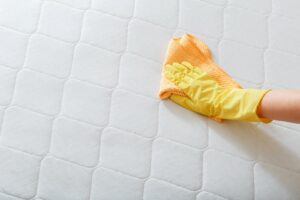How to Wash Your Sheets
Washing your sheets is critical to a healthy night’s sleep. Even if you shower right before bed, dirt, oil, and sweat build up on your sheets overnight. Morning showerers may pick up additional contaminants throughout the day and then introduce them into their sleep environment. The accumulation of dirt can cause breakouts, allergies, and infections.
Weekly launderings lower the risk of adverse effects, and keeping up a weekly sheet-washing schedule is easy with the right process. Whether you wash your sheets in the machine or by hand, cleaning your sheets takes only a few steps.
We’ll explore the importance of washing your sheets regularly, how often you should wash them, the steps to laundering bed sheets with and without a machine, and how to remove stains.
Why You Should Wash Your Sheets Regularly
The average sleeper spends 7 to 8 hours in bed each night, leaving ample time for sweat, body oil, dirt, dead skin cells, and dust mites to build up. And this figure does not account for the additional hours spent reading, watching television, or using electronic devices. Having sex, wearing makeup or skin products overnight, and allowing a pet to sleep in the bed can also make your sheets get dirty more quickly.
Sleepers who forgo regular sheet washing may be at risk of unpleasant effects like skin irritation, acne, and infections. Unwashed sheets can also lead to an increase in dust mites. Although these microscopic bugs do not bite, they can exacerbate allergy symptoms.
The best sheets should hold up well to repeated washing and may even get softer, so laundering your sheets regularly can be a win-win.
How Often Should You Wash Your Sheets?
Sleepers should generally wash their sheets at least once per week. However, the recommended washing frequency varies based on several factors. For instance, sleepers who share their bed with a pet should clean their sheets every three to four days. Those who experience allergies or night sweats should also wash their sheets more frequently.
Sheet Washing Prep: What You’ll Need
In preparation for sheet washing, sleepers should read the product label’s care instructions to determine best practices. The care instructions should indicate whether the sheets are machine-washable or require hand washing. They may also indicate the best water temperature, detergent type, and dryer cycle to use.
Once you understand the manufacturer’s directions, ensure that you have the necessary materials.
Machine-washable sheets require:
- A washer
- A dryer or clothesline
- Gentle detergent
Hand-washable sheets require:
- A large container, sink, or tub
- Cold, warm, or hot water (depending on the fabric type and care instructions)
- Gentle detergent
- A clothesline
How to Wash Sheets
Laundering bed sheets in a washing machine is fairly simple as long as you follow the manufacturer’s care directions. Generally, you should wash sheets in the hottest water recommended on the label. Cotton can usually hold up to hot water. More sensitive fabrics, like silk, typically call for colder temperatures or hand-washing. Most sheets also require a gentle detergent and the tumble dry setting.
- Carefully read and follow all of the care instructions on the label.
- Pretreat any stains.
- Wash your bed sheets separately from other items. Overcrowding the washing machine can prevent a thorough cleanse. Also, wash light and dark sheets separately to avoid color bleeding.
- Set the washing machine to the appropriate temperature setting. Cotton usually requires the hottest water setting. Other materials, such as polyester, call for warm temperatures. Warm and hot water helps kill dust mites and germs.
- Put in a gentle detergent according to your machine’s instructions.
- Set your machine to a gentle cycle.
- Consider washing your bed sheets a second time in just water if you have sensitive skin. This can help remove lingering detergent residue.
- Immediately transfer the bed sheets to the dryer or clothesline to avoid mold growth and odor.
- If you’re using a dryer, set it to tumble dry on low. Hang the sheets on a clothesline if you’re letting them air dry.
How to Get Stains Out of Sheets
Spot removal should always precede the regular wash process because stain removal requires different cleaning products and processes. Generally, getting stains out of sheets involves dabbing the spot with cold water and a cleaning solution, then washing the sheets as normal.
- Strip the sheets from your bed and identify the stains. Each stain may require a slightly different approach.
- Run the stain under cold water to lift it.
- Determine the appropriate cleaning solution. The type of stain dictates the type of cleaning solution needed. Baking soda, vinegar, or a combination of the two are effective for many stains. Tougher stains may require hydrogen peroxide or an enzyme cleaner. Avoid using bleach because it can degrade the fabric.
- Dab the stain with a cloth dipped in the cleaning solution. Avoid rubbing the stain, which can cause it to spread.
- Put the sheets in the washer and clean them as normal.
- Line dry instead of using the machine dryer to avoid setting any lingering stains.
- Once the sheets have air dried, check for stains. Repeat the stain removal process if necessary.
How to Hand Wash Sheets
Delicate fabrics, such as silk, often require an extremely gentle washing process that can only be done by hand. The roughness of machine-washing can quickly damage such materials. Although hand-washing sheets may seem like an intricate process, it’s actually fairly simple.
- Remove the sheets from the bed and read the care instructions on the label.
- Check for stains or discoloration and spot treat them.
- Fill a large container, such as a sink or bathtub, with cold water. Hot temperatures may damage delicate materials.
- Stir in the laundry detergent. The amount of detergent needed depends on the size of the load, but it should usually be equivalent to what you’d put in your washing machine.
- Submerge the bed sheets until they are covered in water.
- Knead the sheets for several minutes to ensure the detergent is evenly distributed. Avoid aggressive motions, such as scrubbing, which can harm delicate fabric.
- Leave the sheets to soak in the container for 15 to 30 minutes.
- For especially dirty sheets, stir the sheets and leave them to soak again. You may repeat this process as needed.
- Drain the sudsy water and rinse the sheets under cold running water to remove the detergent.
- Gently squeeze out excess water and hang them out to dry.

Still have questions? Ask our community!
Join our Sleep Care Community — a trusted hub of sleep health professionals, product specialists, and people just like you. Whether you need expert sleep advice for your insomnia or you’re searching for the perfect mattress, we’ve got you covered. Get personalized guidance from the experts who know sleep best.









